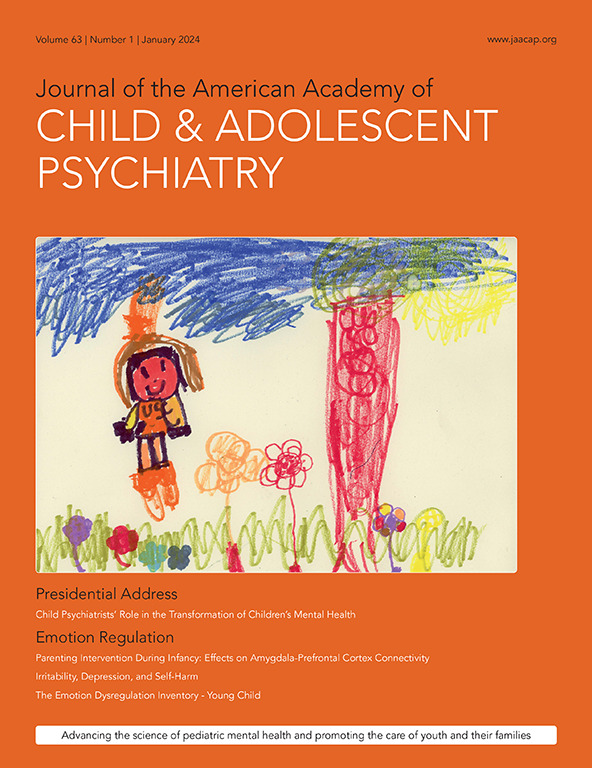Predicting the First Onset of Suicidal Thoughts and Behaviors in Adolescents Using Multimodal Risk Factors: A Four-Year Longitudinal Study.
IF 9.2
1区 医学
Q1 PEDIATRICS
Journal of the American Academy of Child and Adolescent Psychiatry
Pub Date : 2025-07-15
DOI:10.1016/j.jaac.2025.07.006
引用次数: 0
Abstract
OBJECTIVE Suicide is one of the leading causes of death among youth worldwide, yet existing studies that aimed to predict the first onset of suicidal thoughts or behaviors (STB) included a limited number of data modalities, and/or focused on adult populations. We aimed to prospectively predict first-onset STB across four-year follow-ups in adolescents using (1) an existing STB history classification model that was previously applied to baseline data, and (2) a new machine learning model with 195 biopsychosocial features. METHOD The study included 7,503 unrelated adolescents (54.5% female, aged 9-11 years at baseline) from the multisite, longitudinal Adolescent Brain Cognitive Development (ABCD) project. Our existing baseline STB history classification model was applied to predict longitudinal first-onset STB versus healthy controls and clinical controls (those with mental illness but no STB). A new elastic net logistic regression model with 195 features was trained on data from 14 sites (n=5,220) and the resulting top 15 features were validated in seven independent sites (n=2,283). RESULTS Our previously developed model to classify STB lifetime history also prospectively predicted first-onset STB with an area under the curve (AUC)[95%] of 0.73[0.70,0.75], p<.001 relative to healthy controls and AUC[95%] of 0.63[0.60,0.66], p<.001 compared to clinical controls. The newly trained model with top 15 features performed similarly with AUC[95%]=0.73[0.71,0.76], p<.001 and AUC[95%]=0.64 [0.60,0.66], p<.001 for the same comparison groups. The most consistent predictors across models included female sex, sleep disturbances, and maladaptive home and school environments. CONCLUSION Our models predicted first-onset STB in adolescents with moderate accuracy. Our study also confirmed the roles of well-established psychological risk factors for STB and identified several novel neurocognitive and brain imaging risk factors. Future studies should validate our models in large-scale diverse samples before clinical translation.使用多模式危险因素预测青少年首次自杀念头和行为:一项为期四年的纵向研究。
自杀是全球青少年死亡的主要原因之一,但现有的旨在预测自杀念头或行为(STB)首次发作的研究包括有限数量的数据模式,和/或侧重于成人人群。我们的目的是前瞻性地预测青少年首次发病STB的四年随访,使用(1)现有的STB病史分类模型,该模型先前应用于基线数据,以及(2)具有195个生物心理社会特征的新机器学习模型。方法本研究纳入来自多地点纵向青少年脑认知发展(ABCD)项目的7503名无亲属关系的青少年(54.5%为女性,基线年龄为9-11岁)。我们现有的基线STB病史分类模型被应用于预测纵向首发STB与健康对照组和临床对照组(有精神疾病但没有STB的人)的对比。在14个站点(n=5,220)的数据上训练了一个新的具有195个特征的弹性网络逻辑回归模型,并在7个独立站点(n=2,283)中验证了得到的前15个特征。结果我们之前建立的STB生活史分类模型对首次发病的STB也有前瞻性预测,曲线下面积(AUC)[95%]为0.73[0.70,0.75],p<。0.001相对于健康对照组,AUC[95%]为0.63[0.60,0.66],p<。001与临床对照相比。具有前15个特征的新训练模型表现相似,AUC[95%]=0.73[0.71,0.76], p<。0.001, AUC[95%]=0.64 [0.60,0.66], p<。相同的比较组是001。所有模型中最一致的预测因素包括女性性别、睡眠障碍和不适应的家庭和学校环境。结论我们的模型预测青少年首发性STB具有中等准确度。我们的研究还证实了已知的STB心理危险因素的作用,并确定了几个新的神经认知和脑成像危险因素。在临床翻译之前,未来的研究应该在大规模的不同样本中验证我们的模型。
本文章由计算机程序翻译,如有差异,请以英文原文为准。
求助全文
约1分钟内获得全文
求助全文
来源期刊
CiteScore
21.00
自引率
1.50%
发文量
1383
审稿时长
53 days
期刊介绍:
The Journal of the American Academy of Child & Adolescent Psychiatry (JAACAP) is dedicated to advancing the field of child and adolescent psychiatry through the publication of original research and papers of theoretical, scientific, and clinical significance. Our primary focus is on the mental health of children, adolescents, and families.
We welcome unpublished manuscripts that explore various perspectives, ranging from genetic, epidemiological, neurobiological, and psychopathological research, to cognitive, behavioral, psychodynamic, and other psychotherapeutic investigations. We also encourage submissions that delve into parent-child, interpersonal, and family research, as well as clinical and empirical studies conducted in inpatient, outpatient, consultation-liaison, and school-based settings.
In addition to publishing research, we aim to promote the well-being of children and families by featuring scholarly papers on topics such as health policy, legislation, advocacy, culture, society, and service provision in relation to mental health.
At JAACAP, we strive to foster collaboration and dialogue among researchers, clinicians, and policy-makers in order to enhance our understanding and approach to child and adolescent mental health.

 求助内容:
求助内容: 应助结果提醒方式:
应助结果提醒方式:


